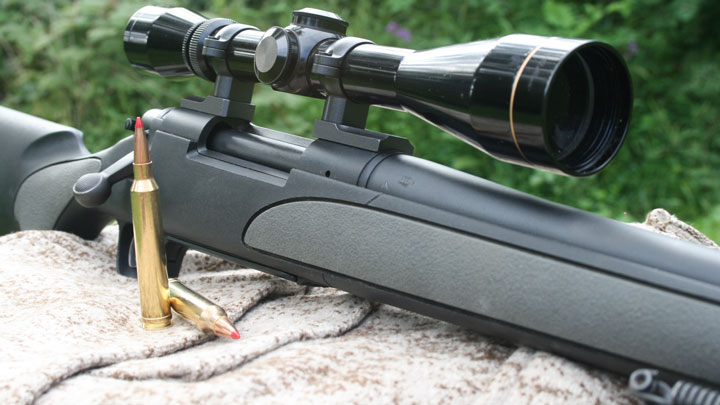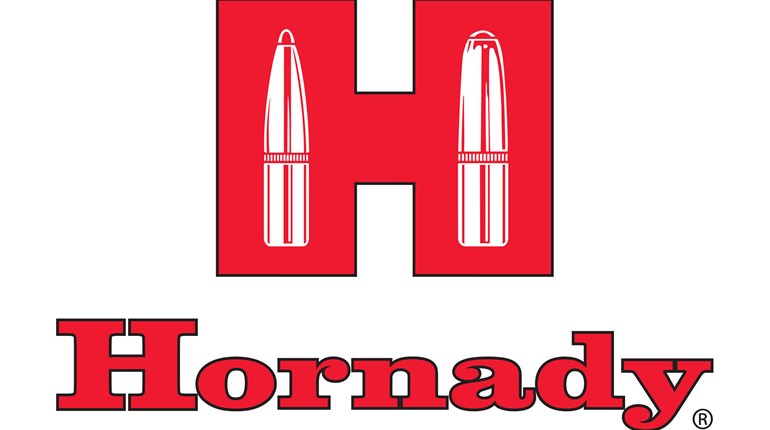
In 1978, Remington unveiled the 8mm Remington Magnum—what it thought to be an ideal cartridge for shooting large game at distance, as well as the equal to Winchester’s popular .338 Winchester Magnum. What company doesn’t want to take market share from a rival, right? The company was correct in that the cartridge was, and still is, well-suited for downing large, distant animals, however its appeal was misjudged. It truly was “a flash in the pan.”
What led to the 8mm Rem. Mag.’s demise? For many riflemen, bullet width was the sticking point. Most 0.323-inch (8-mm) diameter bullets had poor aerodynamic qualities and, at least in America, were insufficiently diverse in design and weight. That wasn’t the case with its chief competitor, the .338 Win. Mag. What’s more, the cartridge required a magnum-length action and generated stout recoil, particularly in lightweight rifles. Few hunters want to be unnecessarily punished. Lastly, other manufacturers weren’t as smitten as Remington with 8mm Rem. Mag., and without widespread support, its fate was forthcoming. Only a small-but-dedicated following keeps it alive today.

The story of the 8mm Rem. Mag. is relevant here because it’s the parent for the 7mm Shooting Times Westerner (STW), the subject of this article. And, as is often the case with cartridges, this child greatly outshone its parent.
From Conception to Adoption: The 7mm STW
Chances are, if you’re a well-read rifleman, shotgunner or hunter, then you’ve seen the name Layne Simpson. An avid writer, shooter and hunter, among other things, Simpson has authored articles for various magazines—including, as you might have surmised, Shooting Times—as well as several books. He’s also a wildcatter.

In true wildcatter fashion, shortly after the introduction of the 8mm Rem. Mag., Simpson began tinkering with it. Decreasing its bullet diameter by a seemingly trivial 1 millimeter resulted in a cartridge that would, in short order, take the shooting community by storm. Interest in the 7mm STW, which easily bested the timeless 7mm Rem. Mag., burgeoned with each piece he penned about it. This led to the cartridge being standardized by the Sporting Arms and Ammunition Manufacturers’ Institute (SAAMI) in 1996. A year later, Remington began producing it. A-Square, however, was the first company to produce ammunition for it, doing so in 1994. After standardization, a host of firearm and ammunition companies joined “Big Green” in supporting the 7mm STW. Meanwhile, gunsmiths were kept busy re-chambering existing rifles in 7mm Rem. Mag. to the new cartridge.
What lead to its uncanny rise in popularity? One word: speed. Speed sells. And the 7mm STW had it in spades.

Specifications & Performance
Outside of the aforementioned change in bullet diameter, nigh all other case dimensions and specifications were kept unchanged. These include cartridge overall length (COL); case length; shoulder angle; and maximum average pressure (MAP). The large case, which Nosler Reloading Guide 7 reports as holding 90 grains water (give or take), and a 65,000 psi MAP, enabled it to frequently outpace the 7mm Rem. Mag. by 200 fps or more. That gain might seem inconsequential, however all else being equal, a bullet that arrives on target faster is less affected by a breeze, has a less-pronounced trajectory and hits harder—all desirable for hunting. Extra velocity also increases the likelihood that the bullet will upset reliably, which is a real concern at long-range hunting.

As an example of the 7mm STW’s excellent external ballistics, when loaded with the 175-grain AccuBond LR at 2900 fps—as it is in Nosler’s Trophy Grade Long Range ammunition—and zeroed at 200 yards, the bullet will drop 6.58, 18.81 and 37.31 inches at 300, 400 and 500 yards, respectively, according to shooterscalculator.com. At the latter distance, the 0.326 G7 BC bullet has 1,932 ft.-lbs. of energy remaining—more than the .30-30 Win. at the muzzle. Ponder that for a moment. Desire something faster? How about Hornady’s Precision Hunter load, which propels a 162-grain ELD-X to 3050 fps. With the same 200-yard zero, the projectile will impact 5.91 inches low at 300 yards, and 16.94 inches at 400. At 500 yards it’ll strike 33.66 inches below the point of aim, and it delivers 1,966 ft.-lbs. of energy. That is plenty for even the biggest bull elk. Keep in mind that, through judicious handloading, the numbers above can be bettered—sometimes significantly so.

The 7mm STW’s cavernous case is also advantageous in that the long, streamlined, heavy-for-caliber bullets ideal for distance work can utilized without sacrificing the invaluable propellant that sends them screaming downrange; there is ample space for powder, even when employing projectiles such as the above-mentioned AccuBond LR, which measures 1.51 inches in length, and the 1.648-inch Berger 195-grain Elite Hunter Hybrid. As the trend toward ever-higher-BC bullets continues, the 7mm STW will be at the forefront of cartridges that can rightly propel them.
Of course, with the good—in some riflemen’s minds—comes the bad. Yes, just like its parent, the 7mm STW requires a magnum action, and the cartridge has the antiquated belt. Like other high-performance cartridges, barrel life can be short if mistreated or overused, and a 26-inch barrel is necessary to achieve top velocities. It’s worth it to me.

Rifles and Loads
Large-scale riflemakers that have chambered the 7mm STW include: Remington Arms (Model 700); Winchester (Model 70); Sako (TRG-S, 75); Savage Arms (Model 114, 116); and Weatherby (Mark V). Occasionally, these rifles, which were manufactured during a short stretch after SAAMI standardization, materialize on gun store shelves. If priced right, they dissolve just as quickly; don’t second-guess a purchase or you’ll miss out.
It’s a rarity nowadays that a new-production rifle is offered in 7mm STW, but it does happen. For instance, the 26-inch-barreled Remington Model 700 SPS in the accompanying photographs was among a run for firearms wholesaler Davidson’s. I recently purchased it secondhand for a little more than four Benjamins.

If you desire a new rifle chambered in 7mm STW, the best bet is to go the custom or semi-custom route. E.R. Shaw, for example, offers it as an option in the company’s semi-custom Mark VII Gen II rifle. Depending on the features selected, Mark VIIs range between $990 and $1,600. Most custom rifle builders can chamber the cartridge, though this is the priciest route. A third option is, should you have a rifle with a suitably sized action that you’re willing to sacrifice, have it re-barreled to 7mm STW by a company such as SSK Firearms, Hart Rifle Barrels, McGowen Precision Barrels, etc. The benefits in following this path are firearm familiarity, affordability (when compared to the price of a new semi-custom or custom rifle), and top-tier performance.
Concerning ammunition, you’ll quickly realize that, unlike the ubiquitous 7mm Rem. Mag., there are limited options in 7mm STW from the large manufacturers, and they’re all costly. Expect to pay $2.00 to $4.50 per round. Fortunately, those that are available are typically loaded with premium, controlled-expansion bullets, which are a must with this cartridge. A quick internet search revealed the following loads: Nosler Trophy Grade Long Range 175-grain AccuBond LR, Trophy Grade 160-grain AccuBond and 140-grain Partition, and Custom 140-grain AccuBond; Hornady Precision Hunter 162-grain ELD-X; Federal 160-grain Trophy Bonded Tip; and HSM Game King 160-grain SBT and Trophy Gold 168- and 180-grain Berger VLD Hunting. With these, you’re prepared for nearly all huntable game.
Reloading will save you money and help diversify your options. Dies are readily available and inexpensive, and brass can be had from Nosler, Bertram, Quality Cartridge and Hornady, with the latter typically being the cheapest—relatively speaking, of course. Remington brass can be found on an inconsistent basis, too. In a pinch, you can neck down 8mm Rem. Mag. brass, though it’s often more difficult to locate than 7mm STW.

As mentioned elsewhere, you’ll want to use premium, controlled-expansion projectiles in the 7mm STW; lesser bullets will cause excessive damage to edible meat, as well as risk failing to reach terminal depths. Some of the best bullets are: Nosler Partition, E-Tip, AccuBond and AccuBond LR; Hornady InterBond and GMX; Barnes TSX and TTSX; Federal Trophy Bonded Tip; Swift Scirocco II and A-Frame; Woodleigh Weldcore; and Speer Grand Slam.

For the 7mm STW, I prefer bullets in the 150-grain-plus weights. When propelled by large doses of extra-slow-burning propellant, these projectiles will reach far, hit hard and penetrate deep. Large rifle magnum primers are a must; most often, reloading manuals suggest the hot-burning Federal 215. I concur. As for the reloading process, it’s uncomplicated; however, the life of the hard-to-find and costly cases can be extended through neck sizing only.
I’ve owned two rifles chambered in 7mm STW: a sorely missed bull-barrel Remington Model 700 with a laminated stock, and the previously mentioned 700 SPS. In general, accuracy is excellent and, surprisingly, recoil is mild given the cartridge’s astounding ballistics. Moving forward, I won’t be without one. I enjoy the cartridge that much.

Time hasn’t been kind to the 7mm STW. Whereas it once dominated the realm of 7mms, such is no longer the case. Not long after its adoption, it was eclipsed by Remington’s own 7mm Remington Ultra Magnum—a behemoth of a cartridge that epitomizes the term “overbore” and outpaces the STW. Moreover, with the advent of technologically advanced propellants, such as those employed in Hornady’s Superformance ammunition, the 7mm Rem. Mag. nearly matches the ballistics of the 7mm STW. No game animal would know the difference. Topping the 7mm Rem. Mag. was the cartridge’s main selling point. And then there’s the newest, high-capacity 7mm cartridge, the .28 Nosler, which can easily top the STW from a standard-length action and a belt-less case. It would appear that 7 mm STW is following its parent into oblivion.
Still, for the hunter who hunts big game in wide-open spaces, or loves ringing distant steel, the 7mm STW gets it done. And it will continue to do so because it’s a well-designed cartridge.



































